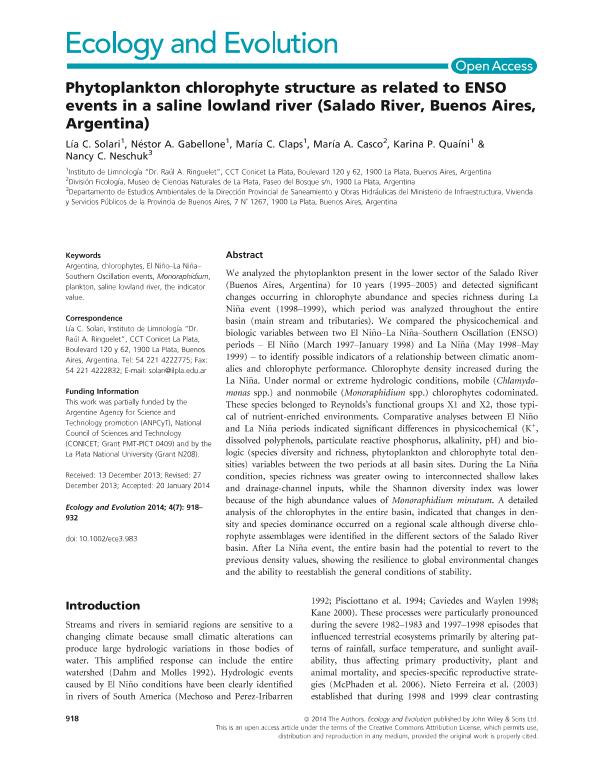Artículo
Phytoplankton chlorophyte structure as related to ENSO events in a saline lowland river (Salado River, Buenos Aires, Argentina)
Solari, Lía Cristina; Gabellone, Nestor Adrian ; Claps, Maria Cristina
; Claps, Maria Cristina ; Casco, Maria Adela
; Casco, Maria Adela ; Quaini, Karina Paola
; Quaini, Karina Paola ; Neschuk, Nancy Carolina
; Neschuk, Nancy Carolina
 ; Claps, Maria Cristina
; Claps, Maria Cristina ; Casco, Maria Adela
; Casco, Maria Adela ; Quaini, Karina Paola
; Quaini, Karina Paola ; Neschuk, Nancy Carolina
; Neschuk, Nancy Carolina
Fecha de publicación:
04/2014
Editorial:
John Wiley & Sons Inc
Revista:
Ecology and Evolution
ISSN:
2045-7758
e-ISSN:
1852-2181
Idioma:
Inglés
Tipo de recurso:
Artículo publicado
Clasificación temática:
Resumen
We analyzed the phytoplankton present in the lower sector of the Salado River (Buenos Aires, Argentina) for 10 years (1995–2005) and detected significant changes occurring in chlorophyte abundance and species richness during La Niña event (1998–1999), which period was analyzed throughout the entire basin (main stream and tributaries). We compared the physicochemical and biologic variables between two El Niño–La Niña–Southern Oscillation (ENSO) periods – El Niño (March 1997–January 1998) and La Niña (May 1998–May 1999) – to identify possible indicators of a relationship between climatic anomalies and chlorophyte performance. Chlorophyte density increased during the La Niña. Under normal or extreme hydrologic conditions, mobile (Chlamydomonas spp.) and nonmobile (Monoraphidium spp.) chlorophytes codominated. These species belonged to Reynolds's functional groups X1 and X2, those typical of nutrient-enriched environments. Comparative analyses between El Niño and La Niña periods indicated significant differences in physicochemical (K+, dissolved polyphenols, particulate reactive phosphorus, alkalinity, pH) and biologic (species diversity and richness, phytoplankton and chlorophyte total densities) variables between the two periods at all basin sites. During the La Niña condition, species richness was greater owing to interconnected shallow lakes and drainage-channel inputs, while the Shannon diversity index was lower because of the high abundance values of Monoraphidium minutum. A detailed analysis of the chlorophytes in the entire basin, indicated that changes in density and species dominance occurred on a regional scale although diverse chlorophyte assemblages were identified in the different sectors of the Salado River basin. After La Niña event, the entire basin had the potential to revert to the previous density values, showing the resilience to global environmental changes and the ability to reestablish the general conditions of stability.
Archivos asociados
Licencia
Identificadores
Colecciones
Articulos(ILPLA)
Articulos de INST.DE LIMNOLOGIA "DR. RAUL A. RINGUELET"
Articulos de INST.DE LIMNOLOGIA "DR. RAUL A. RINGUELET"
Citación
Solari, Lía Cristina; Gabellone, Nestor Adrian; Claps, Maria Cristina; Casco, Maria Adela; Quaini, Karina Paola; et al.; Phytoplankton chlorophyte structure as related to ENSO events in a saline lowland river (Salado River, Buenos Aires, Argentina); John Wiley & Sons Inc; Ecology and Evolution; 4; 7; 4-2014; 918-932
Compartir
Altmétricas



